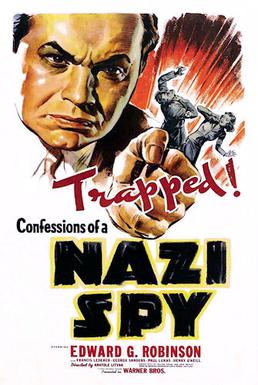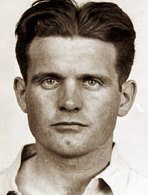Related Research Articles

The Thule Society, originally the Studiengruppe für germanisches Altertum, was a German occultist and Völkisch group founded in Munich shortly after World War I, named after a mythical northern country in Greek legend. The society is notable chiefly as the organization that sponsored the Deutsche Arbeiterpartei, which was later reorganized by Adolf Hitler into the National Socialist German Workers' Party. According to Hitler biographer Ian Kershaw, the organization's "membership list ... reads like a Who's Who of early Nazi sympathizers and leading figures in Munich", including Rudolf Hess, Alfred Rosenberg, Hans Frank, Julius Lehmann, Gottfried Feder, Dietrich Eckart, and Karl Harrer.

The Hitler Youth was the youth organisation of the Nazi Party in Germany. Its origins date back to 1922 and it received the name Hitler-Jugend, Bund deutscher Arbeiterjugend in July 1926. From 1936 until 1945, it was the sole official boys' youth organisation in Germany and it was partially a paramilitary organisation. It was composed of the Hitler Youth proper for male youths aged 14 to 18, and the German Youngsters in the Hitler Youth for younger boys aged 10 to 14.

The German American Bund, or the German American Federation, was a German-American Nazi organization which was established in 1936 as a successor to the Friends of New Germany. The organization chose its new name in order to emphasize its American credentials after the press accused it of being unpatriotic. The Bund was allowed to consist only of American citizens of German descent. Its main goal was to promote a favorable view of Nazi Germany.

The American Nazi Party (ANP) is an American far-right and neo-Nazi political party founded by George Lincoln Rockwell and headquartered in Arlington, Virginia. The organization was originally named the World Union of Free Enterprise National Socialists (WUFENS), a name to denote opposition to state ownership of property, the same year—it was renamed the American Nazi Party in order to attract 'maximum media attention'. Since the late 1960s, a number of small groups have used the name "American Nazi Party" with most being independent of each other and disbanding before the 21st century. The party is based largely upon the ideals and policies of Adolf Hitler's Nazi Party in Germany during the Nazi era, and embraced its uniforms and iconography.

Fritz Julius Kuhn was a German Nazi activist who served as the elected leader of the German American Bund before World War II. He became a naturalized United States citizen in 1934. Still, his citizenship was canceled in 1943 owing to his status as a foreign agent of Nazi Germany. Kuhn served prison time for larceny and forgery from 1939 to 1943 and, upon release, was immediately interned by the federal government as an enemy agent. He was deported in 1945 and later served further prison time in post-war Germany before dying in 1951.
Heinrich "Heinz" Spanknöbel was a German immigrant to America who formed, and for a short time led, the pro-Nazi Friends of New Germany as its Bundesleiter.
Ex parte Quirin, 317 U.S. 1 (1942), was a case of the United States Supreme Court that during World War II upheld the jurisdiction of a United States military tribunal over the trial of eight German saboteurs, in the United States. Quirin has been cited as a precedent for the trial by military commission of unlawful combatants.

George John Dasch was a German agent who landed on American soil during World War II. He helped to destroy Nazi Germany's espionage program in the United States by defecting to the American cause, but was tried and convicted of espionage.

Operation Pastorius was a failed German intelligence plan for sabotage inside the United States during World War II. The operation was staged in June 1942 and was to be directed against strategic American economic targets. The operation was named by Admiral Wilhelm Canaris, chief of the German Abwehr, for Francis Daniel Pastorius, the organizer of the first organized settlement of Germans in America. The plan involved eight German saboteurs who had previously spent time in the United States.

Confessions of a Nazi Spy is a 1939 American spy political thriller film directed by Anatole Litvak for Warner Bros. It was the first explicitly anti-Nazi film to be produced by a major Hollywood studio, being released in May 1939, four months before the beginning of World War II and two and a half years before the United States' entry into the war.

Herbert Hans Haupt was an American spy and saboteur for Nazi Germany during World War II under Operation Pastorius. Haupt would become the only American to be executed by the United States for collaborating with the Axis powers.
Friends of New Germany, sometimes called Friends of the New Germany, was an organization founded in the United States by German immigrants to support Nazism and the Third Reich.

Ernest Peter Burger was a German-American who was a saboteur for Germany during World War II who defected to the United States. A naturalized citizen of the United States who returned to Germany during the Great Depression, Burger was recruited along with seven others by the Abwehr for Operation Pastorius, which sought to sabotage targets in the United States in 1942.
Fascism has a long history in North America, with the earliest movements appearing shortly after the rise of fascism in Europe.

Richard Quirin was a German agent executed as a spy for Nazi Germany in World War II. He was one of eight agents involved in Operation Pastorius, and gave his name to the Supreme Court decision on the trial, Ex parte Quirin.

On February 20, 1939, a Nazi rally took place at Madison Square Garden, organized by the German American Bund. More than 20,000 people attended, and Fritz Julius Kuhn was a featured speaker. The Bund billed the event, which took place two days before George Washington's Birthday, as a pro-"Americanism" rally; the stage at the event featured a huge Washington portrait with swastikas on each side.

Oscar Carl Pfaus was a German immigrant who became an American citizen through military service. He had a succession of jobs before becoming involved in pro-Nazi organizations in Chicago in the early 1930s and becoming a full-time Nazi propagandist there. He was also active in New York.

Nazism in the Americas has existed since the 1930s and continues to exist today. The membership of the earliest groups reflected the sympathies of some German-Americans and German Latin-Americans toward Nazi Germany, embracing the spirit of Nazism in Europe and establishing it within the Americas. Throughout the inter-war period and the outbreak of World War II, American Nazi parties engaged in activities such as sporting Nazi propaganda, storming newspapers, spreading Nazi-sympathetic materials, and infiltrating other non-political organizations.

Edward John Kerling was a spy and saboteur for Nazi Germany and the leader of Operation Pastorius during World War II.
Carl Emil Ludwig Krepper was a German-American Lutheran pastor and Nazi collaborator who assisted the Nazi saboteurs in Operation Pastorius during World War II.
References
- 1 2 Erik V. Wolter, Loyalty on Trial: One American's Battle with the FBI. (iUniverse, 2004) ISBN 9780595327034. p. 62
- 1 2 IMDb Biography
- ↑ Wisconsin Cartographers' Guild, Wisconsin's Past and Present: A Historical Atlas, Univ of Wisconsin Press, 1998, p. 19
- ↑ Wolter, Loyalty On Trial, p. 74
- ↑ Max Wallace, The American Axis - Henry Ford, Charles Lindbergh, and the Rise of the Third Reich. (St. Martin's Griffin, 2003) ISBN 978-0312290221. p. 132
- ↑ Wolter, Loyalty On Trial, pp. 62-63
- ↑ Wolter, Loyalty On Trial, p. 63
- ↑ Wolter, Loyalty On Trial, p. 78
- ↑ Wolter, Loyalty On Trial, p. 64
- ↑ Wolter, Loyalty On Trial, pp. 64-65
- 1 2 Jim Bredemus. "American Bund - The Failure of American Nazism: The German-American Bund's Attempt to Create an American "Fifth Column"". TRACES. Archived from the original on 18 May 2011. Retrieved 2 March 2011.
- ↑ Wolter, Loyalty On Trial, p. 65
- ↑ "New York State Newspapers : New York County (NY) newspapers on microfilm and paper at all NYS locations".
- ↑ Johnson, David Alan (2008). Betrayal: The True Story of J. Edgar Hoover and the Nazi Saboteurs Captured During WWII. Hippocrene Books. p. 288. ISBN 978-0-7818-1173-6. P. 101
- ↑ FBI - George John Dasch and the Nazi Saboteurs Archived May 16, 2016, at the Wayback Machine
- ↑ "Franklin D. Roosevelt: Proclamation 2561—Denying Certain Enemies Access to the Courts". Archived from the original on 9 August 2016. Retrieved 30 December 2016.
- ↑ Spark, Washington Area (1936-01-01), Walter Kappe, director of Nazi saboteurs: 1936 , retrieved 2023-05-29